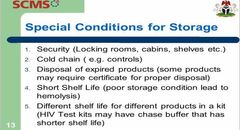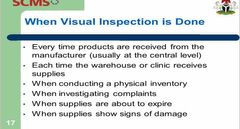![]()
![]()
![]()
Use LEFT and RIGHT arrow keys to navigate between flashcards;
Use UP and DOWN arrow keys to flip the card;
H to show hint;
A reads text to speech;
22 Cards in this Set
- Front
- Back
|
Key storage activities |
1) Material receiving and incoming inspection: This activity occurs during the unloading of vehicles and includes the visual inspection of delivered packages to ensure that products were not damaged during transport. It is also important during this activity that you verify the quantities of products received against the packing slip or shipping invoice. Report any discrepancy. 2) Put away: This process includes moving products from the unloading dock, or receiving area, after they are released for storage; and assigning them to their designated storage area (rack, shelf, loor, etc.). Whether the process is manual or automated, the best practice is to put away products the same day they are received. 3) Picking and packing. To fill shipping requests (or picking lists), products must be located, pulled from inventory, and prepared for shipment. In some cases, products need to be packed into shipment containers or palletized; and, sometimes, bundled with other products into kits before being shipped. 4) Shipping: To guarantee good shipping accuracy, the list of products and their quantities must be checked against shipping orders, or requests, prior to preparing the required shipping documents and loading of the cargo for transport. To avoid damage during transit, products must be arranged and secured within the vehicle using the requirements and conditions for adequate loading and transport. |
|
|
Approximate shelf life of contraceptives |
Four to five years |
|
|
What is shelf life? |
Shelf life is defined as the time necessary for the drug to decay to 90% of its original concentration. Thus, an expiration date is the date beyond which it is predicted that the product may no longer retain fitness for use. |
|
|
Why do you need to clean and disinfect storeroom regularly |
rodents and insects (e.g., termites and roaches) eat oral contraceptives and their packaging. |
|
|
Ideal temperature for storing condoms |
If warehouse temperatures rise above 104 degrees F (40°c),the latex in condoms can break down. |
|
|
How to avoid water damage |
To avoid water damage from moisture that seeps through walls and floors, stack supplies off the floor on pallets at least 10 cm (4 in) high and 30 cm (1 ft) away from walls. |
|
|
Water works well for wood and paper fires but will not work well in |
electrical or chemical fires |
|
|
Effect of fluorescent lights and electric motors on latex products |
Latex products, such as condoms and gloves, can be damaged if they are directly exposed to flourescent lights and electric motors. electric motors and flourescent lights create a chemical called ozone that can rapidly deteriorate condoms. condoms and gloves stored in their proper packaging (i.e., boxes and cartons) will not be affected by limited exposure to ozone.Whenever possible, keep condoms and gloves in their paper boxes and cartons. if this is not possible, move them away from lights and motors. |
|
|
How to store highly flammable products |
Store highly flammable products away from other products and near a fire extinguisher. |
|
|
Measurements for stacking cartons |
Stack cartons at least 10 cm (4 in) off the floor, 30 cm (1 ft) away from the walls and other stacks, and not more than 2.5 m (8 ft) high. Pallets keep products off the floor so they are less susceptible to pest, water, and dirt damage. by keeping pallets 30 cm (1 ft) away from the walls and from each other, you promote air circulation and facilitate the movement of stock, cleaning, and inspection. Stack cartons not more that 2.5 m (8 ft) high, whether or not you use pallets.This is the highest that products can be stacked without crushing the cartons at the bottom. Stacking products at a stable height of less than 2.5 m reduces the possibility of injury to warehouse personnel. Metal shelving is preferred because wood shelving may attract termites. |
|
|
Store medical supplies away from insecticides, chemicals, old files, office supplies |
exposure to insecticides and other chemicals may affect the shelf life. Old files and office supplies, although not a direct hazard, may get in the way , and reduce space for medical supplies or make them less accessible. |
|
|
Arrange cartons well |
arrange cartons so that arrows point up. ensure that identification labels, expiry dates, and manufacturing dates are clearly visible. if shipping cartons do not show the manufacture or expiration dates,or if this information is dificult to read, use a marker to rewrite the dates on the cartons in large,easy-to-read letters and numbers. items should always be stored according to the manufacturer’s instructions on the carton.This includes paying attention to the direction of the arrows on the boxes; storing cartons upside down,for example,can affect the usability of Depo-Provera®. |
|
|
FEFO |
in addition to having visible expiration or manufacture dates,store products so that the first to expire are the easiest to reach. This will ensure that the irst product to expire is the first out (fefO). unfortunately,some warehouses base shipping on the date they received a product,rather than the manufacture or expiration date,often called first-in, first-out (fifO). old stock should be moved or rotated to the front of the shelf,with new stock placed at the back of the shelf. by rotating stock so that the first stock to expire is the most accessible,staff can ensure that the first stock to be issued is the stock that is accessible. |
|
|
When to conduct a visual inspection |
To ensure the quality of the product in your warehouse and pipeline, you should conduct a visual inspection when any of the following occur: • receive products from the manufacturer • warehouse or health facility receives supplies • conduct a physical inventory count • dispense products to a client • issue products from one level to another • receive complaints from lower levels or customers • products are about to expire • products show signs of damage • products have been kept under improper storage conditions. |
|
|
The two types of products on visual inspection |
Products may have two basic types of damage during shipping and storage that afect their quality: mechanical and chemical. Mechanical damage is caused by physical stresses, such as crushing or tearing when the products are loaded, offloaded, or when cartons or inner boxes are stacked. Chemical damage is more difficult to detect and is usually not obvious during a visual inspection. Laboratory testing is usually required. Some indications of chemical damage may include changes in the color, odor, or consistency of the product. |
|
|
Damage to packaging (tears,perforations, water or oil stains,or other damage) and products (such as broken or crumbled pills or tablets or torn packets of condoms or iuDs) |
Discard any damaged items and distribute the remainder as normal. |
|
|
Missing products or empty boxes |
This may indicate pilferage,removal by upper level,or removal by a donor for testing.notify upper level about missing stock |
|
|
Products found outside the warehouse |
all such products will almost certainly have been affected by the elements.any or clinic product left outside for almost any amount of time will probably be damaged from moisture,rain,direct sunlight,and/or pests and should be destroyed according to established procedures. |
|
|
cartons with holes and/or frayed edges |
unlike torn or dirty cartons,holes or frayed edges may be the result,not of handling,but rather of pests.check boxes for signs of termite damage and rats, which are attracted to pills.inspect inner boxes and products for mechanical damage,remove any damaged products,and destroy them according to established procedures.Distribute the remainder as normal. |
|
|
Some options for conducting inventory counts in this situation include— |
cycle counting. Warehouse managers conduct a physical inventory count for a fraction of items each month. By the end of the year, all items have been counted. When the next year starts, they begin the process again. Regular cycle counting can keep physical inventory up-to-date without disrupting store operations. vital, essential, or nonessential (VEN) analysis. This involves counting the most essential, or most expensive items, more often. This analysis categorizes products as vital, essential, or nonessential, enabling you to assess stocks of vital items more often than nonessential items. ABC analysis. In this process, divide products into three categories, based on monetary value. As a logistician, you might also use an ABC analysis that is not based on cost, but on how often a receipt or issue is made. Antibiotics can be issued more often from the warehouse, whereas x-ray equipment may be rarely issued. In this situation, count and assess antibiotic supplies more often. |
|
|
Special conditions for storage |

|
|
|
When visual inspection is done? |

|

